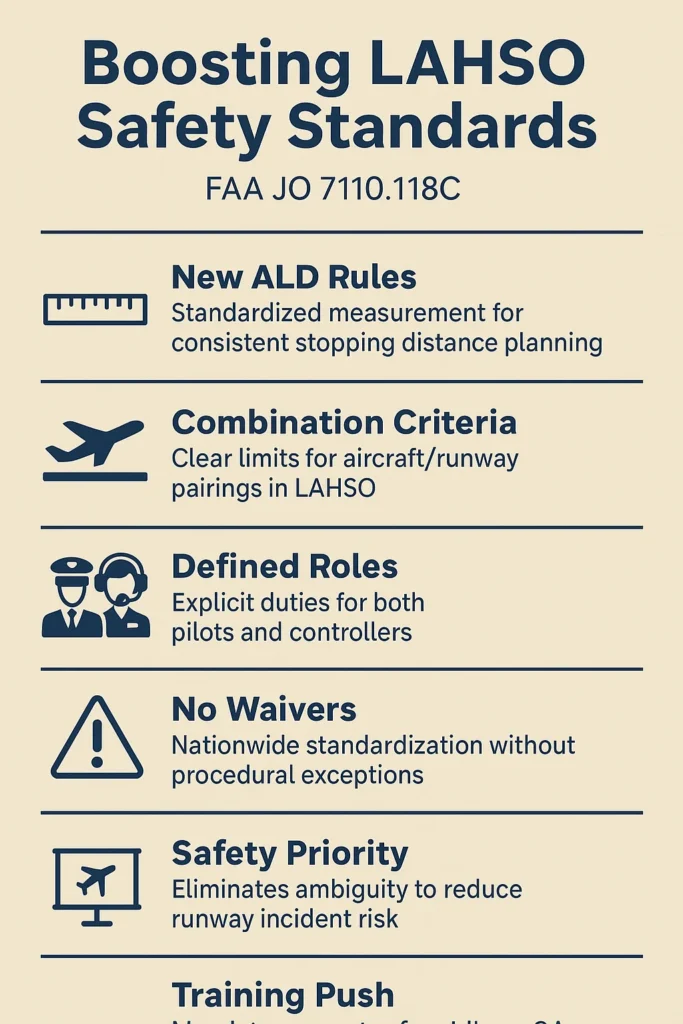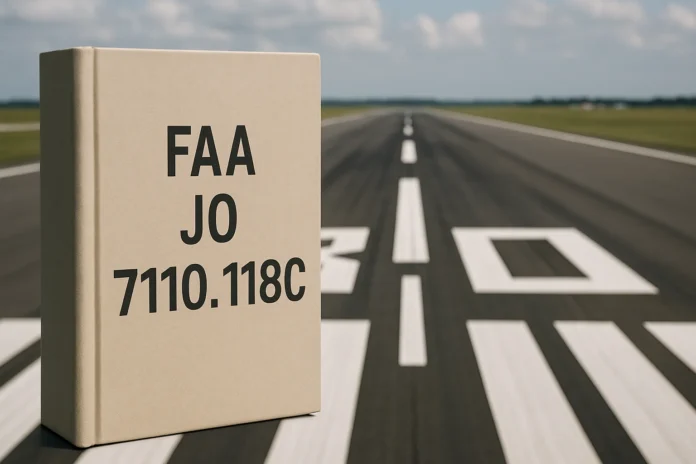Learn about the FAA JO 7110.118C order that revises the procedures and requirements for conducting Land and Hold Short Operations (LAHSO) at U.S. airports
FAA JO 7110.118C: Executive Summary
- FAA issues new LAHSO policy order (JO 7110.118C) effective August 7, 2025
- Replaces previous JO 7110.118B with revised operational responsibilities
- Updates Available: Landing Distance (ALD) guidance and LAHSO combination criteria
- An explicit “no waivers” policy reinforces operational standardization
- Aims to enhance runway safety in complex, high-traffic environments

LAHSO Safety Standards Update
Land and Hold Short Operations (LAHSO) are one of the FAA’s precision tools for maximizing runway efficiency while maintaining safety margins.
On August 7, 2025, the FAA rolled out JO 7110.118C, replacing its predecessor with a more stringent and clearly defined framework for LAHSO Operations.
The update reflects lessons learned from incidents, runway safety audits, and evolving international best practices.
Policy Overview On FAA Runway Safety
What is the policy?
LAHSO procedures allow an aircraft to land and stop before reaching an intersecting runway, taxiway, or other designated point.
Key changes in FAA JO 7110.118C:
Here’s a consolidated comparison table highlighting key segments where FAA Order JO 7110.118C (effective August 7, 2025) differs from its predecessor, JO 7110.118B (effective November 15, 2020).
| Segment | Previous (JO 7110.118B, Nov 2020) | Revised (JO 7110.118C, Aug 2025) |
|---|---|---|
| Cancellation & Incorporation | Cancelled JO 7110.118A; no cross-order integration | Cancels JO 7110.118B; incorporates content from JO 7210.3 and JO 7360.1 for consistency |
| Safety Training Responsibilities | Included responsibilities for Safety and Technical Training (AJI) | Removes AJI responsibilities, as these are now considered core business |
| ALD (Available Landing Distance) Guidance | Established a minimum ALD of 2,500 ft and provided measurement clarification F | Refines roles: ATO Mission Support publishes LAHSO in AIM; ATMs form development teams, issue directives, conduct briefings, and oversee ALD listing; Flight Standards contribute to training and aircraft performance groups; Office of Airports handles infrastructure standards and inspections |
| Organizational Responsibilities | ATO, Flight Standards, Airport Safety & Standards had general duties listed | ATO, Flight Standards, Airport Safety & Standards had general duties listed |
| LAHSO Criteria & Procedures | Minimum ALD: 2,500 ft; air-carrier-specific distance thresholds (arrival/arrival > 3000 ft, arrival/departure < 2000 ft); RLP development required when thresholds not met | Retains these distance thresholds and RLP requirements; further details ALD calculation (use published LDA when shorter), introduces Letter of Authorization for aircraft needing > 8,000 ft ALD (not a waiver) |
| Weather, Ceiling & Visibility Requirements | Set baseline minimums: Non-air carrier: 1,000 ft ceiling & 3 mi visibility; Air carrier: 1,500 ft & 5 mi unless PAPI/VASI present; additional glideslope requirements; humidity/wind shear considerations | Set baseline minimums: Non-air carrier: 1,000 ft ceiling & 3 mi visibility; Air carrier: 1,500 ft & 5 mi unless PAPI/VASI present; additional glideslope requirements; humidity/wind shear considerations. |
| Runway Markings, Signs & Lighting | Requirements for hold-short markings, signs on both sides, single designated hold-short point; L-884 lighting per ACs; lighting termination if multiple failures; ATIS lighting requirements for air carrier vs. non-air carrier at night | Adds more detail: requires braking action at least “good”; tailwind < 3 knots; discontinuation/reinstatement specifics for wind shear/microburst (20-minute wait, advisory removal); layers visibility/ceiling based on VGSI presence/day/night. |
| Eligible Aircraft & Type Designators | LAHSO clearance only to types listed in JO 7360.1; helicopters allowed on request; type groupings used; pilots below 1,000 ft AGL may not accept LAHSO; student pilots prohibited | Continues these but now incorporates JO 7360.1 directly; retains helicopter-on-request, same restrictions on student pilots and low-altitude acceptances |
| Pilot Notification & Read-Backs | ATIS must announce “LAHSO in effect”; closed traffic needs one notification; read-back required; same-day procedures apply | Aircraft/vehicles may cross beyond the hold-short point with notification; all other movement is prohibited; termination if unsafe or weather affects LAHSO. |
| Ground Movement & Termination Conditions | Keeps all these; explicitly maintains the requirement for ATIS content, pilot read-back, and traffic info exchange. | Retains these, with continuity; no significant change in rules, merely carried forward. |
| Letters of Agreement (LOA) | LOA required; must cover procedures, markings, ALD measurement, coordination protocols | Carried forward with the same scope and phrasing |
| Waivers Policy | “No waivers will be issued.” | Reaffirms: no waivers allowed; clarifies LOAs or Letters of Authorization are not waivers |
Summary Highlights
Structural Enhancements: JO 7110.118C improves clarity by integrating relevant content from JO 7210.3 and JO 7360.1 and eliminating duplicative organizational roles like AJI.
Refined ALD Guidance: Now clearly directs use of published LDA if lower than measured ALD and includes authorizations for large aircraft groups requiring > 8,000 ft.
Strengthened Weather/Operational Safety: Adds explicit environmental limits and detailed procedures for wind shear or microburst discontinuation.
Consistent Continuity: Many operational procedures, such as marking, lighting, pilot notifications, and LOA requirements, remain intact from the prior order to ensure consistency and avoid confusion.

Background & Context
LAHSO was first introduced in the 1990s to relieve congestion at busy airports. However, accidents and near-misses—such as runway incursions linked to unclear LAHSO communications—prompted ongoing review.
The National Transportation Safety Board (NTSB) has periodically urged the FAA to tighten procedural language and reinforce pilot/controller training.
Stakeholders & Affected Parties
- Commercial Airlines: Will need to update pilot operating manuals and training syllabi.
- General aviation Pilots: Must review and understand the “no waiver” clause before accepting LAHSO clearances.
- ATC Facilities: Require staff refreshers to ensure uniform application.
- Airport Operators: May see impacts on runway scheduling flexibility.
Industry & Expert Reactions
ATC unions have praised the removal of waivers, citing reduced ambiguity. Airline safety managers welcome the updated ALD metrics, which they say will improve runway excursion risk assessments.
Implementation Challenges & Risks
- Training timelines: Operators must integrate changes into recurrent training cycles.
- Operational rigidity: In some low-traffic situations, the absence of waivers could reduce efficiency.
- Weather sensitivity: Short-runway airports could face increased go-arounds in marginal conditions.
Solutions or Best Practices
- Launch joint ATC–pilot briefings at major hubs.
- Include LAHSO scenarios in simulator sessions before winter operations.
- Share real-world LAHSO performance data between carriers and regulators.
Future Outlook
By removing waiver flexibility, JO 7110.118C signals a shift toward uncompromising adherence to runway safety margins. This could pave the way for new decision-support tools integrating LAHSO feasibility checks directly into ATC systems.
Suggestions for Policy Amendments
Evaluate the implementation of a conditional waiver process specifically designed for low-density airports, which would operate under strict guidelines and carefully controlled circumstances.
This process would require thorough scrutiny and rigorous approval to ensure safety and compliance with aviation regulations.
Conclusion
JO 7110.118C strengthens the safety net around one of ATC’s most delicate balancing acts—maximizing efficiency without compromising safety. For pilots and controllers alike, the message is clear: there is no room for interpretive flexibility where stopping distances and intersecting runways are concerned.
FAQ About FAA JO 7110.118C
Q1: Is LAHSO mandatory for pilots?
No, pilots may decline if they feel conditions are unsafe.
Q2: Does this apply to all U.S. airports?
Only to those authorized for LAHSO operations.
Q3: What’s the main reason for no waivers?
To eliminate inconsistent application across regions.
Q4: Does this change affect runway capacity?
Slightly, in some operational scenarios.
Q5: Are ICAO LAHSO equivalents similar?
Similar in principle, but U.S. standards are more prescriptive.
Sources: FAA _JO_7110.118B, JO_7110.118C,
Pilot’s Handbook of Aeronautical Knowledge (2025): FAA-H-8083-25C Kindle Edition
- By Federal Aviation Administration Staff (Author) Format: Kindle Edition- 4. Rating 4.7 out of 5 stars (224)
- 4.3 on Goodreads
- 751 ratings
#1Best Sellers in Aviation Piloting & Flight Instruction
Last update on 2025-08-18 / Affiliate links / Images from Amazon Product Advertising API


